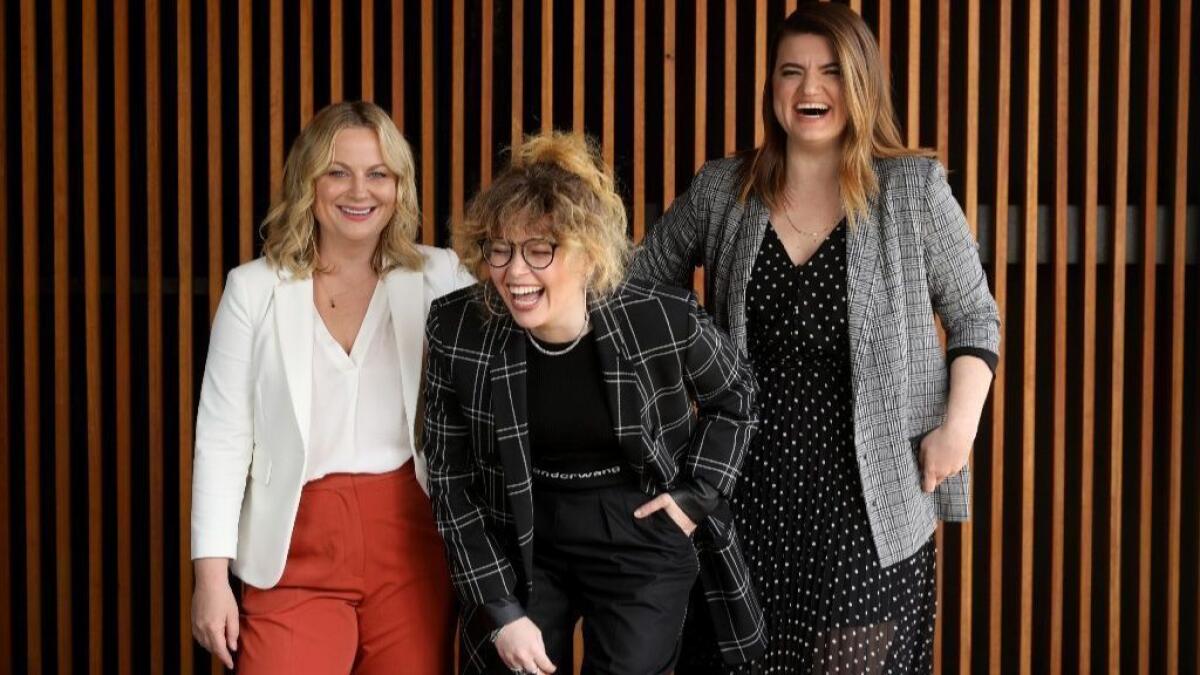‘Russian Doll’ creators explore the mysteries of life in a quirky comedy

On the sunny terrace of the 13th floor of the Netflix building in Hollywood, “Russian Doll” star Natasha Lyonne posed for pictures with creative partners Amy Poehler and Leslye Headland far from the lower Manhattan environs of their stuck-in-a-time-loop breakout show. The eight-episode comedy casts Lyonne as wisecracking New York City video game software designer Nadia Vulvokov, forced to die and re-live the night of her birthday party over and over until she solves the mysteries of her existence.
Profane, brusque, witty and occasionally mournful, Lyonne’s Nadia tangles with sardonic friends, confused lovers and Lower East Side street life in a scrappy quest that met near-unanimous acclaim upon its streaming debut in February.
Fresh off her Emmy-nominated performance in “Orange Is the New Black,” Lyonne created “Russian Doll” with Poehler of “Parks and Recreation” fame and writer-director Headland, who bonded with the actress during the making of their 2016 sex comedy “Sleeping With Other People.” Setting aside their iced coffees, Lyonne, Poehler and Headland settled into a cafeteria banquette and pulled apart the multilayered “Russian Doll” origins story.
Did the high concept for “Russian Doll” spring full-blown from one person or did the three of you figure out the show as you went along?
Lyonne: Amy called me out of the blue to come up with a show together. The seed for “Russian Doll” came out of her earliest idea, which was, “What if you kept going back to the same party and made different choices on a sort of choose-your-own-adventure level, but no matter who you went home with that night, would you be happy? Or would you still feel somehow wanting?
Poehler: I’d been watching “Scenes From a Marriage” and pictured Natasha in bed with someone new for each episode.
Lyonne: Early on, Amy thought maybe we should get 10 playwrights to write an episode, and then I was like [snapping her fingers], “But wait, I’m friends with a major playwright!”
Poehler: Leslye and Natasha very smartly expanded my original idea from “Who am I supposed to be with?” to “Who am I supposed to be?” — which is much more interesting.
Lyonne: So it didn’t really become activated as this three-pronged thing until Leslye joined. The short version I came up with is, Leslye’s “The Shining,” I’m “All That Jazz” and Amy is “Defending Your Life.”
ALSO: ‘Good Omens,’ ‘Killing Eve’ and ‘Russian Doll’: Odd pairings creating compelling TV »
So eventually Leslye wrote the pilot script and “Russian Doll” got a straight-to-order pickup from Netflix?
Lyonne: We pitched the show as a Philip Marlowe for a new generation that was going to have some kind of existential conundrum. They were eager for us to do it.
Poehler: To be clear, the show was made because of Natasha. Concepts are wonderful, but television is very intimate. You’re at home. You want to be with someone on the screen you have a connection to. And people connect with Natasha.
Headland: I usually write complicated female lead characters who do not follow the rules and have little to no redeeming qualities. I’m used to being taken to task for that, whether it’s getting notes behind the scenes, or when the movie comes out and critics are like, “Yeah, but why do I care?” So I agree with Amy. The response to “Russian Doll” has been overwhelming because at the center of it is not just an actor but a soul that is lovable.
Lyonne: I would say as a caveat to all these compliments, which I’m really enjoying, is that despite the wonderful success of “Russian Doll,” I’ve yet to find my Marvel film.
Poehler: [pretending to check phone] I have one for you.
New York City contributes in a big way to the vibe of the show. How did you draw inspiration from Manhattan?
Lyonne: I used to live at the Christodora apartment building on Ninth and B, which has a haunted history, and that became one of the tentpole ideas we brought into our concept. And nearby, I had a friend that lived in the Talmud building.
Poehler: So, the Jewishness coming in.
Lyonne: Additionally, if you see [punk rocker] Richard Hell walking down the street of the East Village, it’s like your … day is made. Capturing that energy and putting our sort of Elliott Gould-as-Philip Marlowe twist on it was really fun, not to mention the physical risk you find around every corner of Manhattan.
The final episode, which Natasha directed, really packs a wallop. How did you arrive at this upbeat ending for such a dark show?
Headland: When I work on something solo I literally have no idea how to end things. Amy, in the [writers] room, kept saying something about wanting some kind of positivity in the ending. I remember in my shriveled-up old soul kind of resisting: “But this show’s about death! Where is the positivity!?” But I couldn’t stop thinking about it.
Poehler: We had to decide, is this a show about life or is it about death?
Nadia’s black clothes and curly mane of red hair resonated right out of the gate. How did you arrive at that look?
Lyonne: [Hair designer] Marcel Dagenais is amazing and knew the smartest move was to have me wear my hair natural. I said to our costume designer Jennifer Rogien, Nadia should look like if Joe Pesci and Marisa Tomei in “My Cousin Vinnie” made a baby. And I wanted it to be flats, because you can’t write, direct, star, produce and also be wearing high heels. It’s just not practical. That’s why you don’t see Larry David in heels. Ever.
Poehler: Yeah, you really don’t.
FULL COVERAGE: Get the latest on awards season from The Envelope »
More to Read
From the Oscars to the Emmys.
Get the Envelope newsletter for exclusive awards season coverage, behind-the-scenes stories from the Envelope podcast and columnist Glenn Whipp’s must-read analysis.
You may occasionally receive promotional content from the Los Angeles Times.






